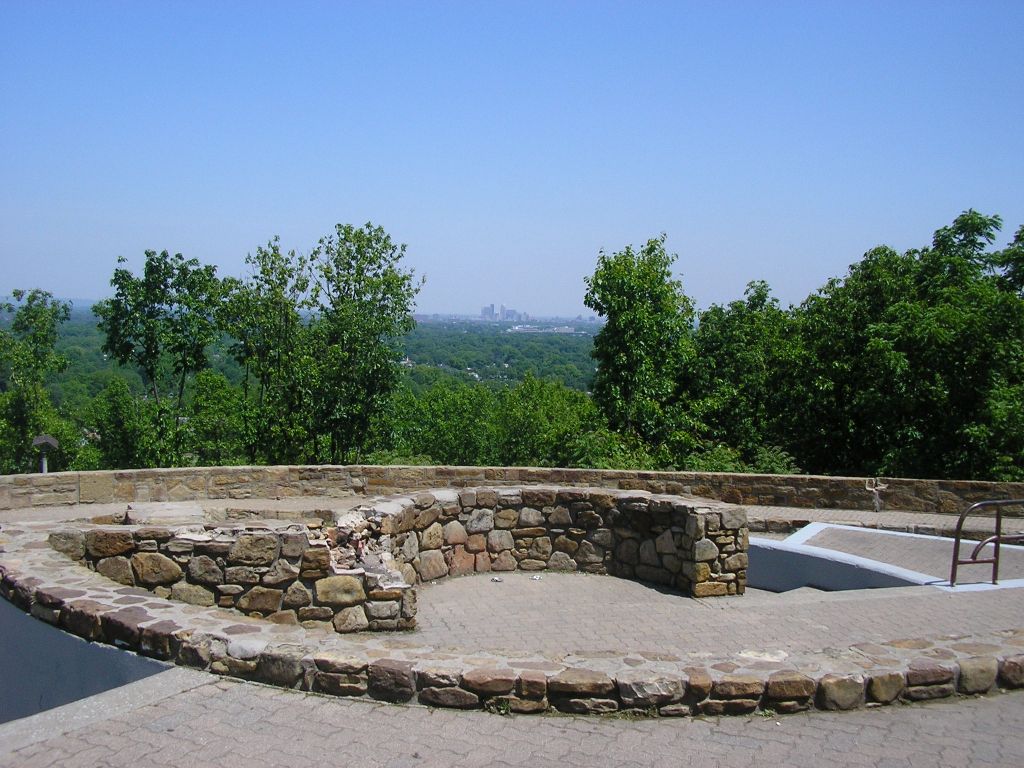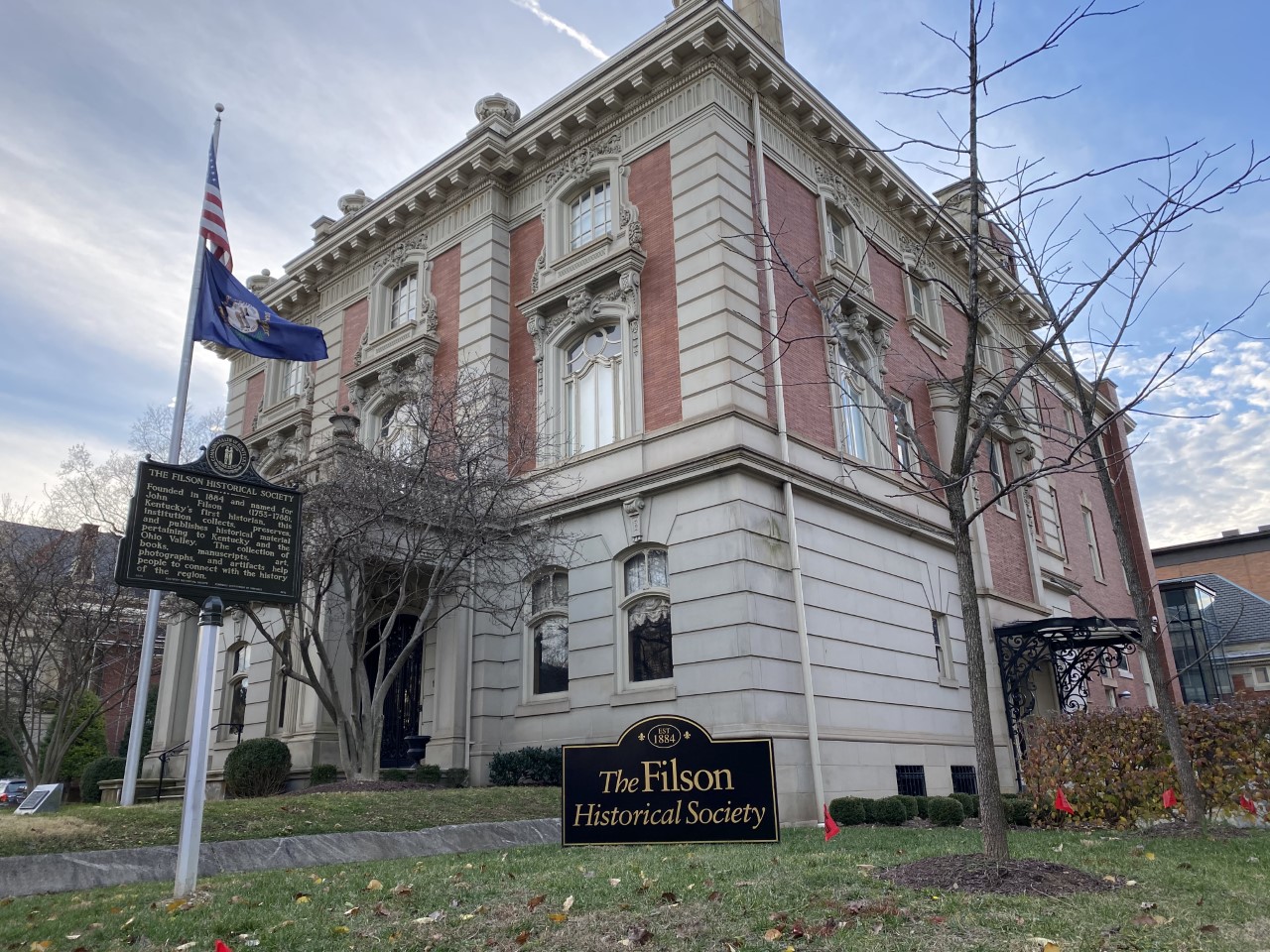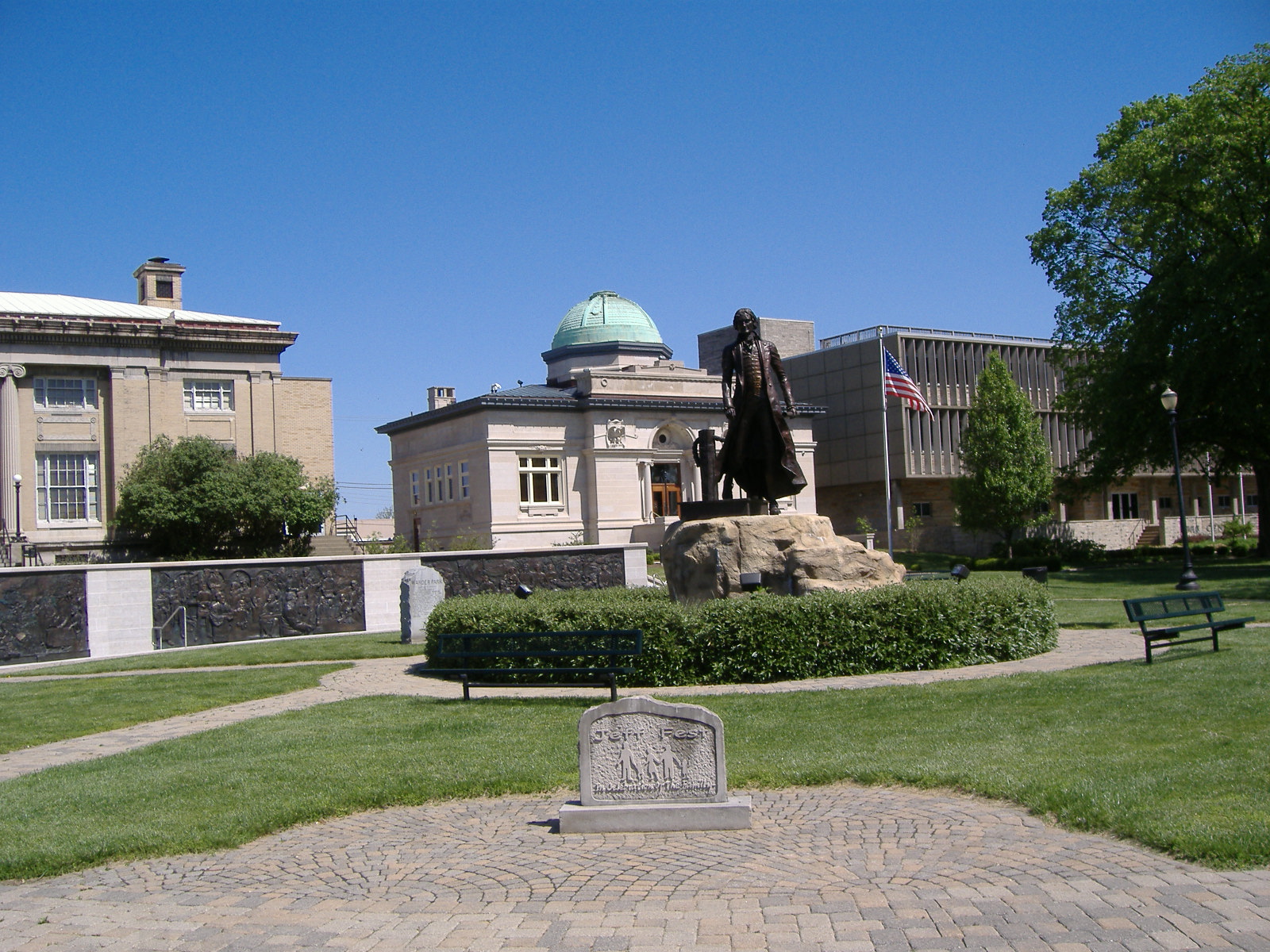|
Fort Nelson (Kentucky)
Fort Nelson, built in 1781 by troops under George Rogers Clark including Captain Richard Chenoweth, was the second on-shore fort on the Ohio River in the area of what is now downtown Louisville, Kentucky. Fort-on-Shore, the downriver and first on-shore fort, had proved to be insufficient barely three years after it was established. In response to continuing attacks from Native Americans and the threat of British attacks during the Revolutionary War, Fort Nelson was constructed between what is currently Main Street and the river, with its main gate near Seventh Street. It was named after Thomas Nelson, Jr., then the governor of Virginia. (Kentucky was part of Virginia at the time.) The fort was used as a courthouse and jail until one was built. The fort was garrisoned until the building of Fort Finney across the river at the site of what is today Jeffersonville, Indiana about 1784. In the fort's place today stands Fort Nelson Park, a shady plaza or 'pocket park' housing a grani ... [...More Info...] [...Related Items...] OR: [Wikipedia] [Google] [Baidu] |
Fort-on-Shore
Fort-on-Shore, built in 1778 by William Linn, was the first on-shore fort on the Ohio River in the area of what is now downtown Louisville, Kentucky. George Rogers Clark had directed Linn to move the militia post to the mainland from its original off-shore location at Corn Island. The fort was located near the current intersection of Twelfth and Rowan Streets. By 1781, the new fort would already prove insufficient, and thus Fort Nelson was constructed upriver. See also *History of Louisville, Kentucky The geology of the Ohio River, with but a single series of rapids halfway in its length from the confluence of the Monongahela and Allegheny rivers to its union with the Mississippi, made it inevitable that a town would grow on the site. Louisvi ... References * Former buildings and structures in Louisville, Kentucky Forts in Kentucky History of Louisville, Kentucky Kentucky in the American Revolution Pre-statehood history of Kentucky {{Louisville-struct-stub ... [...More Info...] [...Related Items...] OR: [Wikipedia] [Google] [Baidu] |
Fort Nelson
{{disambig, geo ...
Fort Nelson may refer to: Canada *Fort Nelson, British Columbia, a town *Fort Nelson River, British Columbia * Fort Nelson (Manitoba) (1670–1713), an early fur trading post at the mouth of the Nelson River and the first headquarters of the Hudson's Bay Company United Kingdom *Fort Nelson, Hampshire, England (built 1860–1867), a Palmerston Fort and present-day museum United States *Fort Nelson (Kentucky), built in 1781 *Fort Nelson (Virginia), first constructed in 1776 See also *Camp Nelson (other) Camp Nelson can refer to: *Camp Nelson, California Camp Nelson is a census-designated place in Tulare County, California. Camp Nelson is east of Springville. Camp Nelson has a post office with ZIP code 93208. The population was 109 at the ... [...More Info...] [...Related Items...] OR: [Wikipedia] [Google] [Baidu] |
History Of Louisville, Kentucky
The geology of the Ohio River, with but a single series of rapids halfway in its length from the confluence of the Monongahela and Allegheny rivers to its union with the Mississippi, made it inevitable that a town would grow on the site. Louisville, Kentucky was chartered in the late 18th century. From its early days on the frontier, it quickly grew to be a major trading and distribution center in the mid 19th century, important industrial city in the early 20th, declined in the mid 20th century, before revitalizing in the late 20th century as a culturally-focused mid-sized American city. The history of Louisville, Kentucky spans a bit over two centuries since the latter part of the 18th century. Prior to arrival of Europeans, the region was depopulated from the Beaver Wars of the 17th century, and no permanent Native American settlements existed in the area. It was used as hunting grounds by northern Shawnee and southern Cherokee. The area's geography and location on the Ohio ... [...More Info...] [...Related Items...] OR: [Wikipedia] [Google] [Baidu] |
Kentucky In The American Revolution
Kentucky ( , ), officially the Commonwealth of Kentucky, is a state in the Southeastern region of the United States and one of the states of the Upper South. It borders Illinois, Indiana, and Ohio to the north; West Virginia and Virginia to the east; Tennessee to the south; and Missouri to the west. Its northern border is defined by the Ohio River. Its capital is Frankfort, and its two largest cities are Louisville and Lexington. Its population was approximately 4.5 million in 2020. Kentucky was admitted into the Union as the 15th state on June 1, 1792, splitting from Virginia in the process. It is known as the "Bluegrass State", a nickname based on Kentucky bluegrass, a species of green grass found in many of its pastures, which has supported the thoroughbred horse industry in the center of the state. Historically, it was known for excellent farming conditions for this reason and the development of large tobacco plantations akin to those in Virginia and North Carolina in ... [...More Info...] [...Related Items...] OR: [Wikipedia] [Google] [Baidu] |
Parks In Louisville, Kentucky
Following is a list of parks, forests and nature preserves in the Louisville metropolitan area. Louisville Metro (Jefferson County) Frederick Law Olmsted Parks The Frederick Law Olmsted Parks (formerly called the Olmsted Park System) in Louisville was the last of five such systems designed by Frederick Law Olmsted. All of the parks in this system are managed by Louisville Metro Parks. Flagship * Cherokee Park * Iroquois Park * Shawnee Park Other parks * Algonquin Park * Baxter Square * Bingham Park — Originally known as Clifton Park (Locals called it Coral Park) * Boone Square * Central Park * Chickasaw Park * Churchill Park * Elliott Square * Seneca Park * Shelby Park * William B. Stansbury Park — Originally known as Third Street Playground * Tyler Park * Victory Park * Wayside Park * Willow Park — Originally part of the main entrance to Cherokee Park Parkways * Algonquin Parkway * Eastern Parkway * Northwestern Parkway * Southern Parkway * Southwestern Pa ... [...More Info...] [...Related Items...] OR: [Wikipedia] [Google] [Baidu] |
Forts In Kentucky
A fortification is a military construction or building designed for the defense of territories in warfare, and is also used to establish rule in a region during peacetime. The term is derived from Latin ''fortis'' ("strong") and ''facere'' ("to make"). From very early history to modern times, defensive walls have often been necessary for cities to survive in an ever-changing world of invasion and conquest. Some settlements in the Indus Valley civilization were the first small cities to be fortified. In ancient Greece, large stone walls had been built in Mycenaean Greece, such as the ancient site of Mycenae (famous for the huge stone blocks of its 'cyclopean' walls). A Greek '' phrourion'' was a fortified collection of buildings used as a military garrison, and is the equivalent of the Roman castellum or English fortress. These constructions mainly served the purpose of a watch tower, to guard certain roads, passes, and borders. Though smaller than a real fortress, they ... [...More Info...] [...Related Items...] OR: [Wikipedia] [Google] [Baidu] |
Former Buildings And Structures In Louisville, Kentucky
A former is an object, such as a template, gauge or cutting die, which is used to form something such as a boat's hull. Typically, a former gives shape to a structure that may have complex curvature. A former may become an integral part of the finished structure, as in an aircraft fuselage, or it may be removable, being using in the construction process and then discarded or re-used. Aircraft formers Formers are used in the construction of aircraft fuselage, of which a typical fuselage has a series from the nose to the empennage, typically perpendicular to the longitudinal axis of the aircraft. The primary purpose of formers is to establish the shape of the fuselage and reduce the column length of stringers to prevent instability. Formers are typically attached to longerons, which support the skin of the aircraft. The "former-and-longeron" technique (also called stations and stringers) was adopted from boat construction, and was typical of light aircraft built until the ... [...More Info...] [...Related Items...] OR: [Wikipedia] [Google] [Baidu] |
American Revolutionary War Forts
American(s) may refer to: * American, something of, from, or related to the United States of America, commonly known as the "United States" or "America" ** Americans, citizens and nationals of the United States of America ** American ancestry, people who self-identify their ancestry as "American" ** American English, the set of varieties of the English language native to the United States ** Native Americans in the United States, indigenous peoples of the United States * American, something of, from, or related to the Americas, also known as "America" ** Indigenous peoples of the Americas * American (word), for analysis and history of the meanings in various contexts Organizations * American Airlines, U.S.-based airline headquartered in Fort Worth, Texas * American Athletic Conference, an American college athletic conference * American Recordings (record label), a record label previously known as Def American * American University, in Washington, D.C. Sports teams Soccer * Ba ... [...More Info...] [...Related Items...] OR: [Wikipedia] [Google] [Baidu] |
The Filson Historical Society
The Filson Historical Society, founded in 1884, is a privately supported historical society located at 1310 South 3rd Street in Louisville, Kentucky. The Filson is an organization dedicated to providing continuing adult education in the form of quarterly peer-reviewed academic journal, Ohio Valley History, a quarterly magazine, The Filson, weekly lectures, historical tours, and exhibits. The Filson's mission is to collect, preserve, and tell the stories of Kentucky and Ohio Valley history and culture. In 2017, the Filson began a new initiative to document, preserve, and study the history of Jewish life and experience in Louisville and the Ohio Valley region, establishing the Jewish Community Archive. The Filson hosts programs and exhibitions that engage critically and honestly with the past with topics such as: Commemorating Juneteenth, David Blight's talk on Frederick Douglas, Christina Snyder's discussion of ''Great Crossings: Indians, Settlers, and Slaves in the Age of Jackson'', ... [...More Info...] [...Related Items...] OR: [Wikipedia] [Google] [Baidu] |
Virginia
Virginia, officially the Commonwealth of Virginia, is a state in the Mid-Atlantic and Southeastern regions of the United States, between the Atlantic Coast and the Appalachian Mountains. The geography and climate of the Commonwealth are shaped by the Blue Ridge Mountains and the Chesapeake Bay, which provide habitat for much of its flora and fauna. The capital of the Commonwealth is Richmond; Virginia Beach is the most-populous city, and Fairfax County is the most-populous political subdivision. The Commonwealth's population was over 8.65million, with 36% of them living in the Baltimore–Washington metropolitan area. The area's history begins with several indigenous groups, including the Powhatan. In 1607, the London Company established the Colony of Virginia as the first permanent English colony in the New World. Virginia's state nickname, the Old Dominion, is a reference to this status. Slave labor and land acquired from displaced native tribes fueled the ... [...More Info...] [...Related Items...] OR: [Wikipedia] [Google] [Baidu] |
Jeffersonville, Indiana
Jeffersonville is a city and the county seat of Clark County, Indiana, Clark County, Indiana, United States, situated along the Ohio River. Locally, the city is often referred to by the abbreviated name Jeff. It lies directly across the Ohio River to the north of Louisville, Kentucky, along Interstate 65 in Kentucky, I-65. The population was 49,447 at the 2020 United States census, 2020 census. Jeffersonville began its existence as a settlement around Fort Finney after 1786 and was named after Thomas Jefferson in 1801, the year he took office. History 18th century Pre-founding The foundation for what would become Jeffersonville began in 1786 when Fort Finney was established near where the John F. Kennedy Memorial Bridge, Kennedy Bridge is today. United States Army, U.S. Army planners chose the location for its view of a nearby bend in the Ohio River, which offered a strategic advantage in the protection of settlers from Native Americans in the United States, Native America ... [...More Info...] [...Related Items...] OR: [Wikipedia] [Google] [Baidu] |








